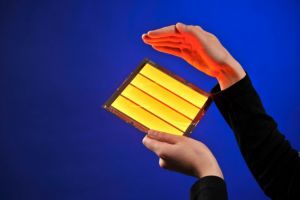We had the good chance to talk with Gerd Guenther, Novaled 's Chief Marketing Officer. He was kind enough to answer a few of our questions, and give us some information and updates from Novaled.
's Chief Marketing Officer. He was kind enough to answer a few of our questions, and give us some information and updates from Novaled.
Gerd, thanks for your time. Can you explain Novaled's business model to us?
When Novaled started as a spin-off from Fraunhofer and Technical University of Dresden in 2001 with just 3 people, the idea was to market its doping technology Novaled PIN OLED®) along with its proprietary materials. Today, quite an impressive number of well known display and lighting makers are customers of Novaled. That means we offer IP, licensing and technology transfer packages but also R&D contracting as well as trainings.
 Novaled 15x15 cm white OLED
Novaled 15x15 cm white OLED
To participate in Novaled’s technological advances, some of our clients want a transfer of know how and experience in manufacturing and engineering, others require a dedicated development program to enhance the performance of their products. Several customers and big players in the display field make use of our small molecular organic materials and license of patents which allow for significantly increased efficiencies of organic electronic devices and can also decrease manufacturing costs.
For the lighting field we also provide tailor-made OLED devices on glass or metal substrates to lamp and luminaire producers. Besides lighting and display, we support further application fields for organic electronic like organic solar cells and organic thin film transistors.
Are there any products that are 'Novaled-inside'?
Yes, there are display and lighting products in the market with Novaled inside. However, due to contracts and NDA’s we cannot to disclose any details.
Can you update us about your flexible and transparent OLED display materials and OLED lighting panels?
Novaled’s display materials are transport materials and associated dopants for electron and hole transport as well as blocker materials. Those materials allow for low voltage OLEDs, tandem devices, top emitting OLEDs and inverted OLEDs.
For flexible OLEDs both a flexible substrate and flexible encapsulation is needed. Novaled is working on both topics and achieved a 35 lm/W for a white OLED on metal which is a record. Lifetime is over 60,000 hours. An intermediate step towards flexible OLEDs will be bended OLEDs.
Transparent OLEDs with an active area of 100 cm², more than 10,000 hours lifetime, a transparency of about 60% and an efficiency of more than 20 lm/W have been demonstrated in several luminaire prototypes at the light and building fair in Frankfurt.

Can you explain your relationship with BASF and Plextronics?
Novaled develops transport-, blocking-, doping-, interlayer- and outcoupling-materials. To ensure an on-demand availability of mass production volumes in a high quality we have a well established long term partnership with our foundry BASF.
A year ago Plextronics and Novaled started a joint development on doped and solution processed organic materials for OLED applications. The Goal of the collaboration agreement was to combine our technologies to develop an advanced solution processible Hole Injection Layer (HIL) technology for OLEDs. Novaled and Plextronics aim to offer a solution processed HIL with the same performance as a Novaled doped small molecule HIL deposited in a vacuum process. The cooperation is ongoing and is making progress.
How is your technology different from the competition?
Novaled has more than 400 patents (including granted and pending patents), most of them in the field of organic dopant materials, OLED structures and device architectures. This gives Novaled a unique position in the OLED field. It should be noted that Novaled is not a competitor for manufacturers of emitting materials since Novaled is not developing those kinds of material.
Novaled focuses on transport materials for both electron and hole transport. The offer includes host and dopant materials. Said materials are used in OLEDs, organic solar cells and OTFTs. So far, no other set of hole and electron transport materials allows for comparably efficient devices. The lowest voltages reported for OLEDs stem from Novaled PIN devices. In addition, Novaled has strong IP in the field of tandem devices.
What is your view on OLED Lighting? is phosphorescent materials a "must"? is roll-to-roll printing the best way to lower costs?
Definitely there are lighting applications which can be realized with fluorescent emitters. We do believe that between 20 and 30 lm/W can be achieved with those emitter systems. However, if we speak about general lighting, phosphorescent red and green emitters are a must. By combining those with a fluorescent blue, one can produce OLEDs with more than 50 lm/W and very long lifetime.
Ideally also phosphorescent blue emitters are used. Currently their status is not good enough. Even with fluorescent blue, the field of general lighting can be opened.
Roll-to-roll printing might be one way to reduce costs. It is rather questionable if that is the best way. Too many problems still need to be resolved. That includes the manufacturing tools, the OLED encapsulation, the printing processes and the performance of the printed OLEDs.
You are investing a lot into metal substrates. Is that the best solution for OLED panels?
Depending on the application, the right substrate needs to be chosen.
There are certainly advantages for OLEDs on metal, but it surely also depends on the application. For transparent in off state applications the only way is to use glass, for example. Metal substrates like steel or aluminum have excellent barrier properties, flexibility and robustness for handling. OLEDs on metal can be used in applications where magnetic clipping of the OLEDs is intended or where soldering, drilling and similar assembly steps are required. Furthermore, metal will also allow for bended or bendable OLED solutions.
 Novaled OLED on metal
Novaled OLED on metal
As this substrate material has very good heat conducting properties, OLEDs on metal are advantageous in application where heat dissipation is critical. In addition, metal substrate opens the roadmap towards low cost roll-to-roll mass production of OLEDs.
We meanwhile have a profound know how on how to build OLEDs on metal. Together with Arcelor Mittal Novaled has been developing OLED structures for steel substrates since 2006. In the German project Rollex Novaled contributed since 2007 to develop OLEDs on flexible aluminium substrates.
Back in March, we heard you are working with a European car maker on interior OLED lighting. Was that a true report?
The story published back in March was a mis-interpretation of what was said by Novaled. We can confirm that we are closely cooperating with a leading European subcontractor for the automotive industry. But we cannot disclose the current status nor further details.
Can you share your view of the future of OLED displays and lighting?
In the flat panel display market, OLED technology is seen as an evolutionary replacement for LCD technology. Several display makers prepare a volume production for OLEDs for the display field. As a close cooperation partner and supplier in this industry segment we note that the current market demand for mobile applications is remarkably exceeding available production capacities. For this reason we do expect a ramping up of tools and equipment at manufacturer sites in the coming two years. In addition it is expected that OLED displays will enter the TV market pretty soon.
Like other new technologies we see the OLED lighting developing in different phases. OLED lighting appears to be well timed for a breakthrough, market entry is done and we are currently in a kind of acceleration phase. Evidence on the ground supports this viewpoint. A number of companies such as Osram, Philips and Panasonic have already demonstrated application-ready lighting modules. In addition, several funded programs are supporting product development efforts with ambitious roadmaps.
Concerning future market players, there might be completely new players not being active in the lighting field so far, which will enter this industry segment, e.g. substrate suppliers or display makers.
In terms of applications OLED lighting will reinvigorate the use of lighting in existing applications and extend the reach of lighting into new areas. Specific demands for thin, high quality, area light are already evident in automotive and medical markets and a desire for embedded large area lighting exists. OLED lighting has the power to open up a whole new market for decorative and low maintenance lighting in the construction industry.
Gerd, thanks again for your time. I wish you and Novaled the best of luck...

